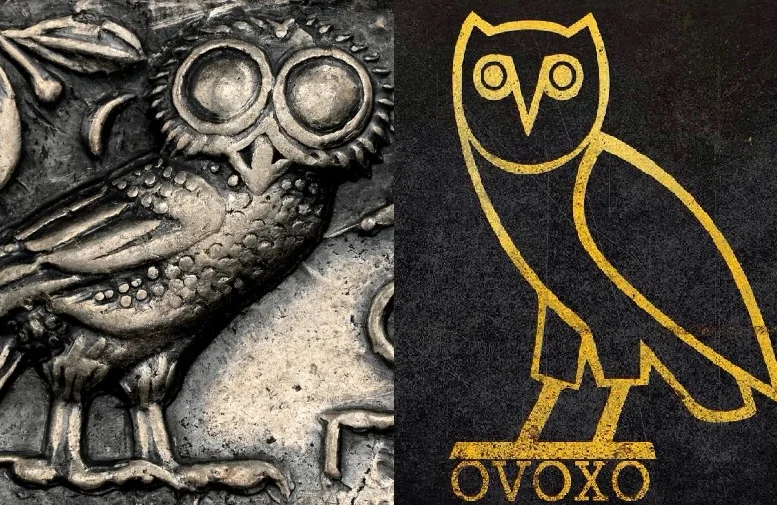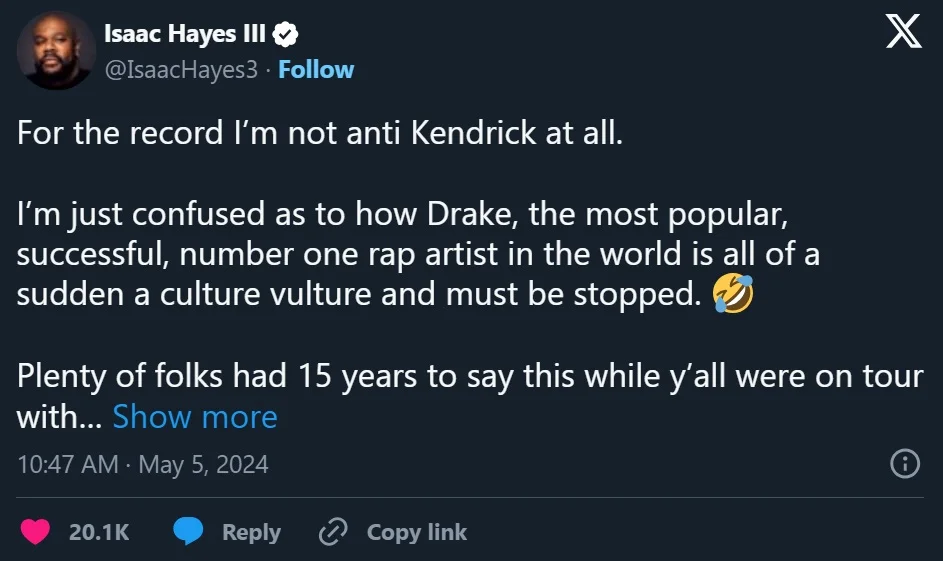For years, Drake has been one of the most recognizable figures in music. His OVO Sound logo, featuring a stylized owl, is almost as famous as the artist himself. But a growing chorus of voices online are pointing out a striking resemblance between Drake’s owl and a design found on ancient Athenian coins, specifically the 440 B.C. Silver Tetradrachm.
This resemblance has ignited a fiery debate, adding fuel to the long-standing accusations that Drake is a “culture vulture,” someone who borrows heavily from other cultures without giving proper credit or demonstrating genuine understanding. Is this just a coincidence, or is there more to the story?
Let’s dive into the details and see if we can untangle this web of accusations.
The Athenian Owl: A Symbol of Wisdom and Power
To understand the current controversy, we need to travel back to ancient Greece. In the bustling city-state of Athens, around the 5th century BCE, a specific coin design became iconic: the Athenian Owl. These coins, primarily made of silver, were not just currency; they were symbols of Athenian identity and values.
One side of the coin, the “heads” or obverse, typically featured a profile image of Athena, the goddess of wisdom, warfare, and the protector of Athens. The other side, the “tails” or reverse, displayed symbols associated with Athena, most notably an owl and an olive branch.
The owl, with its piercing gaze and association with nocturnal activity, was a symbol of wisdom and knowledge. It represented Athena’s sharp intellect and her ability to see clearly, even in the dark. The olive branch, on the other hand, symbolized peace and prosperity, reflecting Athens’ aspirations for a stable and thriving society.
These coins were more than just pocket change; they were mini-billboards, spreading Athenian values and influence throughout the ancient Mediterranean. The Athenian Owl became synonymous with the city’s power, intellect, and cultural achievements.
The OVO Owl: Did Drake Steal the Athenian Owl Design?
Fast forward to the 21st century and the rise of Drake. In 2012, he launched OVO Sound, a record label and lifestyle brand that quickly gained popularity. The logo for OVO is a sleek, minimalist owl.
The OVO owl is a stylized depiction, with sharp lines and a modern aesthetic. It’s a far cry from the detailed engravings of the ancient Athenian coins. Yet, despite the differences in style, the basic form is undeniably similar: a bird with large eyes and a distinctive owl-like appearance.
The OVO owl has become a symbol of Drake’s brand, appearing on everything from album covers to clothing lines. It represents his music, his lifestyle, and his overall image. Just as the Athenian Owl represented the values of ancient Athens, the OVO owl represents the values of Drake’s brand: success, sophistication, and a certain level of cool.
Now for the reveal, take a look at the Athenian Owl Coin side by side with Drake’s OVO Logo. Do they look the almost same to you, or are people on social media tripping?

The Conspiracy Takes Flight: Social Media Weighs In
The internet loves a good conspiracy theory, and the resemblance between the Athenian Owl and the OVO owl has not gone unnoticed.
Social media platforms are buzzing with discussions, comparisons, and accusations. Many users are posting side-by-side images of the ancient coins and the OVO logo, highlighting the similarities in shape, posture, and overall design.
The comments range from playful observations to serious accusations of cultural appropriation. Some users are simply amused by the coincidence, while others see it as further evidence of Drake’s alleged lack of originality.
One Twitter user wrote, “Drake’s owl logo looking a little too much like that ancient Greek coin…smh.” A Reddit thread dedicated to ancient coins even features discussions about the OVO logo, with users debating the likelihood of intentional copying.
The controversy has even spread to other online communities, with bloggers and commentators weighing in on the debate. Some argue that the resemblance is purely coincidental, pointing out that owls are a common symbol and that the OVO logo is a stylized interpretation.
Others maintain that the similarities are too striking to ignore, suggesting that Drake or his design team must have been aware of the Athenian Owl when creating the logo.
Culture Vulture Accusations: A Pattern of Borrowing?
The owl logo controversy is not happening in a vacuum. It’s part of a larger narrative that has dogged Drake for years: the accusation that he is a “culture vulture.”
This term very common in the hip-hop world, describes someone who exploits the culture of others for personal gain, often without understanding or respecting the source material. Kendrick Lamar accused Drake of this in his viral diss track “Not Like Us“.
Critics argue that Drake has a history of borrowing from various cultures and subcultures, adopting their sounds, styles, and slang for his own benefit. They point to instances where he has been accused of appropriating accents, mimicking musical styles, and even lifting lyrics from other artists.
One prominent example is the controversy surrounding his use of Jamaican Patois. While Drake has collaborated with numerous Jamaican artists and incorporated elements of dancehall into his music, some critics have accused him of using the accent inauthentically, simply to gain credibility and appeal to a wider audience.
Another instance that drew heavy criticism was the ghostwriting allegations. In 2015, it was revealed by Meek Mill that Drake had used Quentin Miller as a ghostwriter on several tracks. This sparked a major controversy, with many accusing Drake of being disingenuous and undermining the authenticity of his music.
More recently, he was accused of stealing lyrics from an Irish toast for his song “Popstar.”
Although it is a common practice in modern music to take inspiration from disparate sources, detractors are keen to point out what they believe is an overt act of cultural pilfering.
These accusations have fueled the perception that Drake is not a genuine artist, but rather a chameleon-like figure who adapts to whatever is popular at the moment. The owl logo controversy, in this context, becomes just another piece of evidence supporting this narrative.
Defending the OVO Owl: Coincidence or Homage to Athenian Culture?
Of course, not everyone agrees with the culture vulture accusations.
Drake’s defenders argue that he is simply an artist who is inspired by a wide range of influences. They point out that borrowing and sampling are common practices in music, and that Drake is simply participating in a long tradition of artistic cross-pollination.
Some argue that the resemblance between the Athenian Owl and the OVO logo is purely coincidental. Owls are a common symbol, appearing in various cultures and contexts throughout history.
It’s possible that Drake’s design team simply came up with the owl logo independently, without any knowledge of the ancient coins.
Others suggest that even if Drake was aware of the Athenian Owl, his use of the image could be seen as an homage rather than an act of appropriation. By referencing the ancient symbol of wisdom and knowledge, Drake could be trying to associate his brand with those same values.

Furthermore, some within the hip-hop community have defended Drake, suggesting that the accusations leveled against him are hypocritical.
They point out that many artists collaborate with Drake and benefit from his platform, making the claims of cultural appropriation seem disingenuous.
Director Isaac Hayes III, for example, questioned the timing of the accusations, asking why so many artists were willing to work with Drake for years before suddenly denouncing him as a culture vulture.

The Authenticity Debate: What Does It Mean to Be a Culture Vulture?
At the heart of the Drake controversy lies a fundamental question about authenticity. In a that everything is sampled, remixed, and reinterpreted, what does it mean to be original? Is it possible to create something truly new, or are we all just building upon the work of those who came before us?
For some, authenticity means staying true to one’s roots, representing a specific culture or community with pride and integrity. For others, authenticity is about expressing oneself honestly, regardless of where those expressions come from.
Drake seems to occupy a space somewhere in between these two extremes. He is a Canadian artist with a diverse background, drawing inspiration from various cultures and styles. He is not afraid to experiment, to push boundaries, and to challenge expectations.
However, this willingness to embrace different influences has also made him a target for criticism. By not adhering to a strict definition of authenticity, he has opened himself up to accusations of being inauthentic, of being a poser, of being a culture vulture.
A Modern Day Tetradrachm? The Power of Symbols
Whether intentional or not, the similarities between the OVO owl and the Athenian tetradrachm highlight the enduring power of symbols. Both images, separated by millennia, represent something larger than themselves.
The Athenian Owl symbolized the wisdom, power, and cultural achievements of ancient Athens. The OVO owl symbolizes the success, sophistication, and cool factor of Drake’s brand. Both owls have become iconic, instantly recognizable symbols that resonate with millions of people.
Just as the Athenians used their coins to spread their message throughout the ancient, Drake uses his logo to promote his brand in the modern . In a way, the OVO owl is a modern-day tetradrachm, a symbol that carries meaning and influence far beyond its simple form.
The Verdict: Guilty or Not Guilty?
So, is Drake guilty of stealing the OVO logo from an Athenian coin? Is he a culture vulture with no originality? The answer, like most things in life, is not so simple.
There is no definitive evidence to prove that Drake intentionally copied the Athenian Owl. The resemblance could be a coincidence, or it could be an homage. Ultimately, it’s up to each individual to decide what they believe.
However, the controversy raises important questions about cultural appropriation, authenticity, and the role of symbols in our society. It forces us to examine our own assumptions about originality and to consider the complex ways in which artists borrow, sample, and reinterpret the work of others.
Whether you see Drake as a brilliant innovator or a shameless appropriator, he has sparked a conversation that is worth having. And perhaps, in the spirit of the Athenian Owl, that is a sign of wisdom.
Explore Related Articles

Is Atlantic Records Using FEDS to Trap NBA Youngboy in Bad...
New details have come out about NBA Youngboy's federal case, and people think something strange is going on behind the scenes. It's alleged that NBA Youngboy could be released from prison before his trial, but the stipulations seem to bode well for the label he was trying to break...
Was FBG Cash Set Up by a Female? FBG Cash Dead...
The shooting death of rapper FBG Cash in Chicago's South Side has been ruling the hip-hop headlines. According to reports after an unknown shooter in a black Cadillac pulled up on him, he was shot dead in a shootout that ensued. Now photos of FBG Cash's dead body have...
Memphis Rapper Kevo Muney Hitting a Game Winning Three Point Shot...
When most people think of Adam Sandler, they usually think of some of the worst comedy movies ever made. However, some people think of the moment Memphis Rapper Kevo Muney hit a game winning three point shot in Adam Sandler's face during a pickup basketball game.
Adam Sandler was playing...






